Effect of Nanosized Precipitates on Corrosion Resistance of Nb-Microalloyed Steels
Abstract
:1. Introduction
2. Materials and Methods
3. Results
3.1. Investigation of Nonmetallic Inclusions
3.2. Microstructure Investigation
3.3. Investigation of the Precipitation of Excess Phases
4. Discussion
Author Contributions
Funding
Data Availability Statement
Conflicts of Interest
References
- Lesch, C.; Kwiaton, N.; Klose, F.B. Advanced high strength steels (AHSS) for automotive applications—Tailored properties by smart microstructural adjustments. Steel Res. Int. 2017, 88, 1700210. [Google Scholar] [CrossRef]
- Pouraliakbar, H.; Khalaj, G.; Jandaghi, M.R.; Khalaj, M.J. Study on the correlation of toughness with chemical composition and tensile test results in microalloyed API pipeline steels. J. Min. Metall. Sect. B-Metall. 2015, 51, 173–178. Available online: http://www.jmmab.com/images/pdf/2015/23_soctwccttrmaps-nov-2015-173-178.pdf (accessed on 1 January 2022). [CrossRef]
- Villalobos, J.C.; Del-Pozo, A.; Campillo, B.; Mayen, J.; Serna, S. Microalloyed Steels through History until 2018: Review of Chemical Composition, Processing and Hydrogen Service. Metals 2018, 8, 351. [Google Scholar] [CrossRef] [Green Version]
- DeArdo, A.J. Niobium in modern steels. Int. Mater. Rev. 2003, 48, 371–402. [Google Scholar] [CrossRef]
- Garcia, C.I.; Hua, M.; Cho, K.; DeArdo, A.J. On the strength of microalloyed steels—An interpretive review. Metall. Ital. 2009, 11, 35–42. Available online: https://www.academia.edu/10782168/On_strength_of_microalloyed_steels_an_interpretive_review (accessed on 19 July 2013).
- Larzabal, G.; Isasti, N.; Rodriguez-Ibabe, J.M.; Uranga, P. Evaluating strengthening and impact toughness mechanisms for ferritic and bainitic microstructures in Nb, Nb-Mo and Ti-Mo microalloyed steels. Metals 2017, 7, 65. [Google Scholar] [CrossRef] [Green Version]
- Zaitsev, A.; Arutyunyan, N. Low-carbon Ti-Mo microalloyed hot rolled steels: Special features of the formation of the structural state and mechanical properties. Metals 2021, 11, 1584. [Google Scholar] [CrossRef]
- Zaitsev, A.; Koldaev, A.; Arutyunyan, N.; Dunaev, S.; D’yakonov, D. Effect of the chemical composition on the structural state and mechanical properties of complex microalloyed steels of the ferritic class. Processes 2020, 8, 646. [Google Scholar] [CrossRef]
- Sanz, L.; Pereda, B.; López, B. Effect of thermomechanical treatment and coiling temperature on the strengthening mechanisms of low carbon steels microalloyed with Nb. Mater. Sci. Eng. A 2017, 685, 377–390. [Google Scholar] [CrossRef]
- Bu, F.Z.; Wang, X.M.; Yang, S.W.; Shang, C.J.; Misra, R.D.K. Contribution of interphase precipitation on yield strength in thermomechanically simulated Ti–Nb and Ti–Nb–Mo microalloyed steels. Mater. Sci. Eng. A 2014, 620, 22–29. [Google Scholar] [CrossRef]
- Zhang, K.; Li, Z.; Wang, Z.; Sun, X.; Yong, Q. Precipitation behavior and mechanical properties of hot-rolled high strength Ti–Mo-bearing ferritic sheet steel: The great potential of nanometer-sized (Ti, Mo)C carbide. J. Mater. Res. 2016, 31, 1254–1263. [Google Scholar] [CrossRef]
- Jiang, S.; Wang, H.; Wu, Y.; Liu, X.; Chen, H.; Yao, M.; Gault, B.; Ponge, D.; Raabe, D.; Hirata, A.; et al. Ultrastrong steel via minimal lattice misfit and high-density nanoprecipitation. Nature 2017, 544, 460–464. [Google Scholar] [CrossRef]
- Kong, H.J.; Liu, C.T. A Review on nano-scale precipitation in steels. Technologies 2018, 6, 36. [Google Scholar] [CrossRef] [Green Version]
- Gladman, T. Precipitation hardening in metals. Mater. Sci. Technol. 1999, 15, 30–36. [Google Scholar] [CrossRef]
- Chen, W.; Gao, P.; Wang, S.; Lu, H.; Zhao, Z. Effect of vanadium on hydrogen embrittlement susceptibility of high-strength hot-stamped steel. J. Iron Steel Res. Int. 2020, 28, 211–222. [Google Scholar] [CrossRef]
- Huang, W. Suppression of hydrogen-induced damage in 22MnB5 hot stamping steel by microalloying. Mater. Chem. Phys. 2020, 256, 123–129. [Google Scholar] [CrossRef]
- Takahashi, J.; Kawakami, K.; Kobayashi, Y.; Tarui, T. The first direct observation of hydrogen trapping sites in TiC precipitation-hardening steel through atom probe tomography. Scr. Mater. 2010, 63, 261–264. [Google Scholar] [CrossRef]
- Stopher, M.A.; Rivera-Diaz-del-Castillo, P.E.J. Hydrogen embrittlement in bearing steels. Mater. Sci. Technol. 2016, 32, 1184–1193. [Google Scholar] [CrossRef]
- Jiao, Z.B.; Luan, J.H.; Miller, M.K.; Chung, Y.W.; Liu, C.T. Co-precipitation of nanoscale particles in steels with ultra-high strength for a new era. Mater. Today 2017, 20, 142–154. [Google Scholar] [CrossRef]
- Rodionova, I.G.; Amezhnov, A.V.; D’yakonov, D.L.; Shaposhnikov, N.G.; Baklanova, O.N.; Gladchenkova, Y.S. Study of the effect of microstructure characteristics on corrosion resistance of cold-rolled micro-alloyed sheet steels (HSLA) of strength classes 340–420 for automobile building. Metallurgist 2020, 63, 1165–1177. [Google Scholar] [CrossRef]
- Rodionova, I.; Amezhnov, A.; Alekseeva, E.; Gladchenkova, Y.; Vasechkina, I. Effect of carbonitride precipitates on the corrosion resistance of low-alloy steels under operating conditions of oil-field pipelines. Metals 2021, 11, 766. [Google Scholar] [CrossRef]
- Amezhnov, A.V.; Rodionova, I.G.; Batsalev, A.I.; D’yakonov, D.L.; Shaposhnikov, N.G.; Shatskii, T.E.; Marzoeva, M.E. Effect of chemical composition and microstructure parameters on carbon and low-alloy steel corrosion resistance under oil industry pipeline operation conditions. Metallurgist 2019, 62, 1030–1038. [Google Scholar] [CrossRef]
- Rodionova, I.G.; Amezhnov, A.V.; Kudashov, D.V.; Naumenko, V.V.; D’yakonov, D.L.; Stukalova, N.A.; Arutyunyan, N.A. Effect of heat treatment in pipe processing stage on corrosion resistance of micro-alloyed steel hot-rolled products. Metallurgist 2020, 64, 322–333. [Google Scholar] [CrossRef]
- Rodionova, I.G.; Shapovalov, E.T.; Kovalevskaya, M.E.; Baklanova, O.N.; Burko, D.A.; Endel’, N.I.; Gusev, Y.B.; Gliner, R.E.; Lamukhin, A.M.; Kuznetsov, V.V.; et al. Increasing the resistance of automobile sheet to atmospheric corrosion by optimizing its chemical composition and the parameters of the manufacturing process. Metallurgist 2005, 49, 314–323. [Google Scholar] [CrossRef]
- Rodionova, I.G.; Amezhnov, A.V.; Shaposhnikov, N.G.; Gladchenkova, Y.S.; D’yakonov, D.L. Features of the effect of microstructure characteristics on corrosion resistance of cold-rolled high-strength low-alloy steels (HSLA) grade 260–300 for automobile building. Metallurgist 2020, 63, 920–932. [Google Scholar] [CrossRef]
- Shaposhnikov, N.G.; Rodionova, I.A.; Pavlov, A.A. Thermodynamic development of austenite-martensite class corrosion-resistant steels intended for a bimetal cladding layer. Metallurgist 2016, 59, 1195–1200. [Google Scholar] [CrossRef]
- Amezhnov, A.V.; Rodionova, I.G.; Kuznetsov, D.V.; Komissarov, A.A.; Sidorova, E.P. Effect of heat treatment on corrosion activity of nonmetallic inclusions and steel corrosion resistance in aqueous media. Metallurgist 2019, 62, 1232–1239. [Google Scholar] [CrossRef]
- Townsend, H.E. Effects of alloying elements on the corrosion of steel in industrial atmospheres. Corrosion 2001, 57, 497–501. [Google Scholar] [CrossRef]
- Nam, N.D.; Kim, M.J.; Kim, J.G. Corrosion behavior of low alloy steels containing manganese in mixed chloride sulfate solution. Metall. Mater. Trans. A 2014, 45, 893–905. [Google Scholar] [CrossRef]
- Ralston, K.D.; Birbilis, N. Effect of grain size on corrosion: A review. Corrosion 2010, 66, 075005–075005-13. [Google Scholar] [CrossRef]
- Ghosh, S.; Singh, A.K.; Mula, S.; Chanda, P.; Vinay, V.; Mahashabde, V.V.; Roy, T.K. Mechanical properties, formability and corrosion resistance of the mechanically controlled processed Ti-Nb stabilized IF steel. Mater. Sci. Eng. A 2017, 684, 22–36. [Google Scholar] [CrossRef]
- Hadzima, B.; Janecek, M.; Estrin, Y.; Kim, H.S. Microstructure and corrosion properties of ultrafine-grained interstitial free steel. Mater. Sci. Eng. A 2007, 462, 243–247. [Google Scholar] [CrossRef]
- Krishna, K.G.; Sivaprasad, K.; Sankaro Narayanan, T.S.N.; Hari Kumar, K.C. Localized corrosion of an ultrafine grained Al–4Zn–2Mg alloy produced by cryorolling. Corros. Sci. 2012, 60, 89. [Google Scholar] [CrossRef]
- Zhang, H.; Xue, P.; Wu, L.H.; Song, Q.N.; Wang, D.; Xiao, B.L.; Ma, Z.Y. Effect of grain ultra-refinement on corrosion behavior of ultra-high strength high nitrogen stainless steel. Corros. Sci. 2020, 174, 108847. [Google Scholar] [CrossRef]

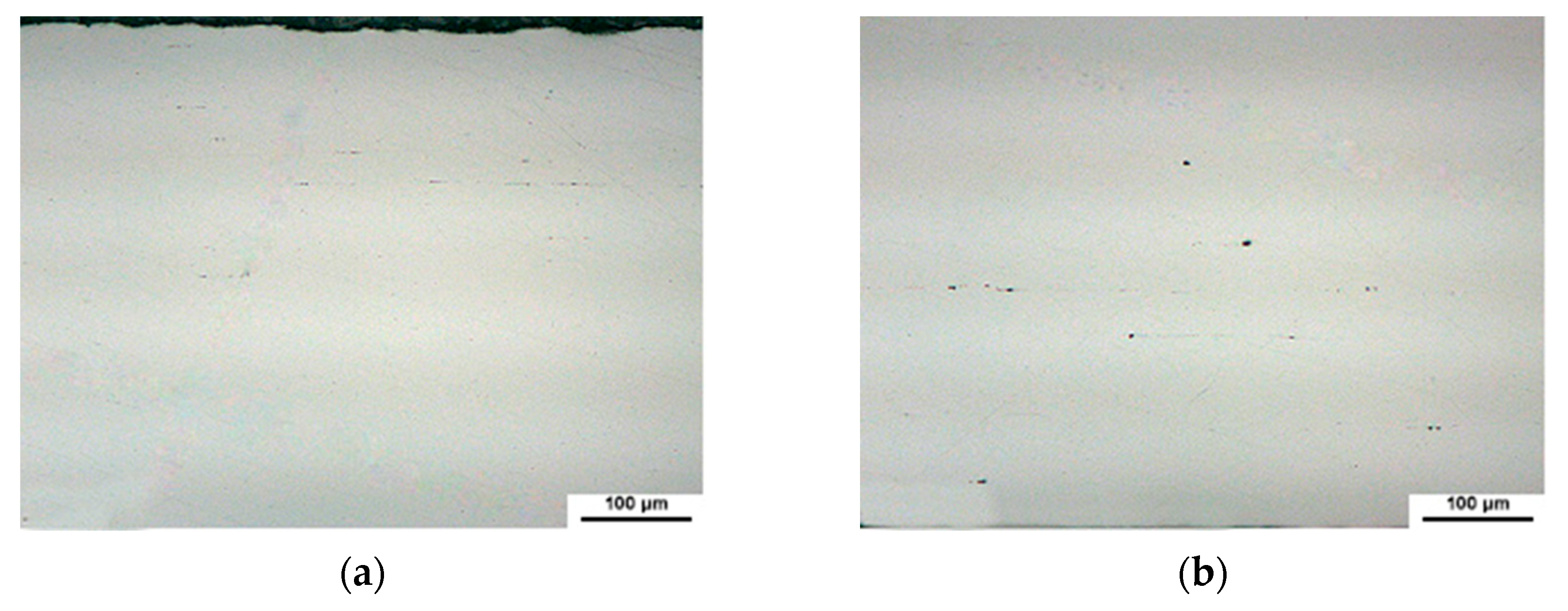
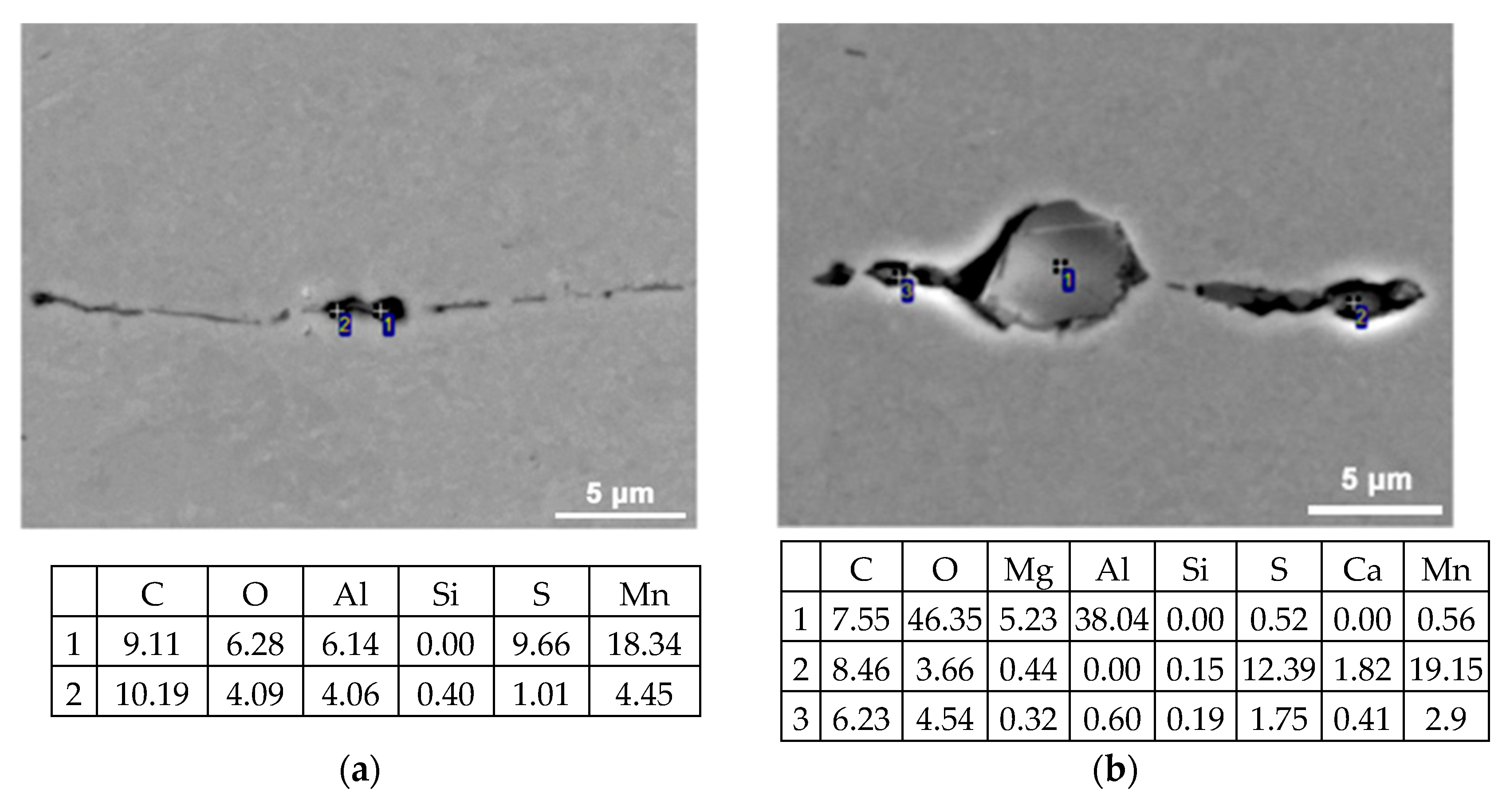
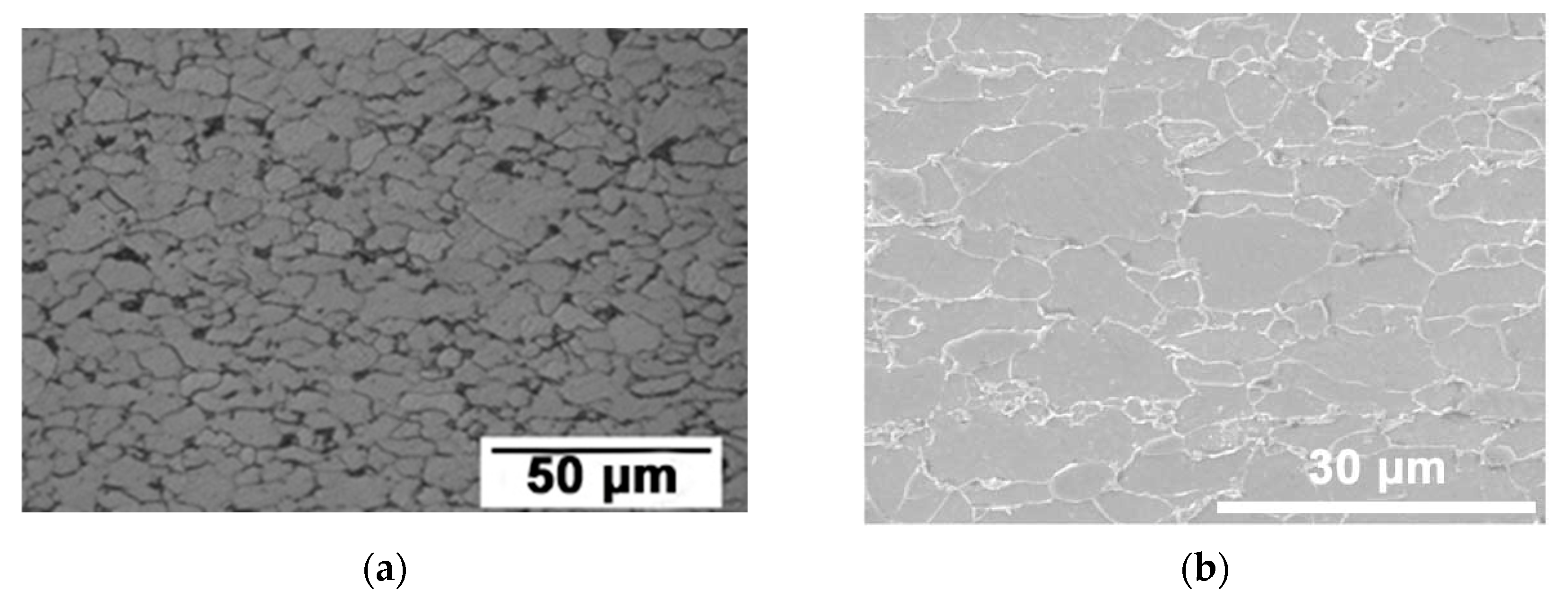

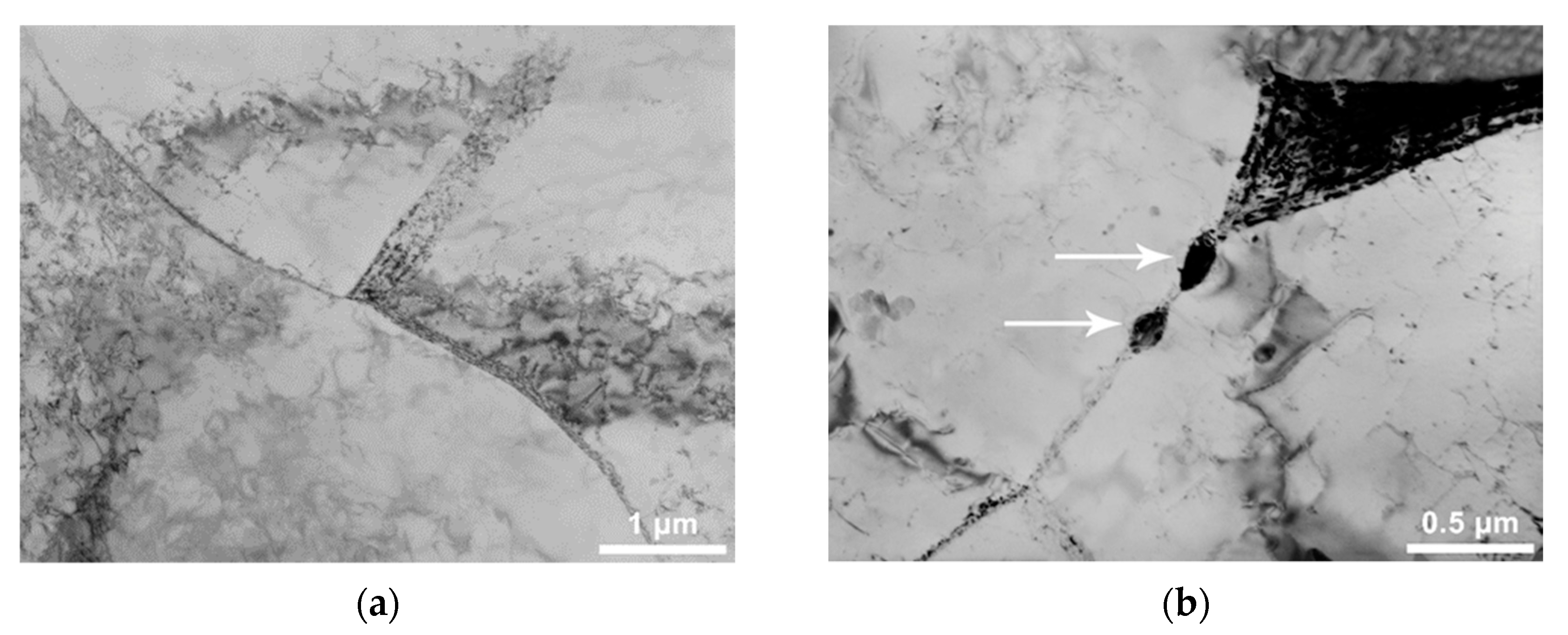
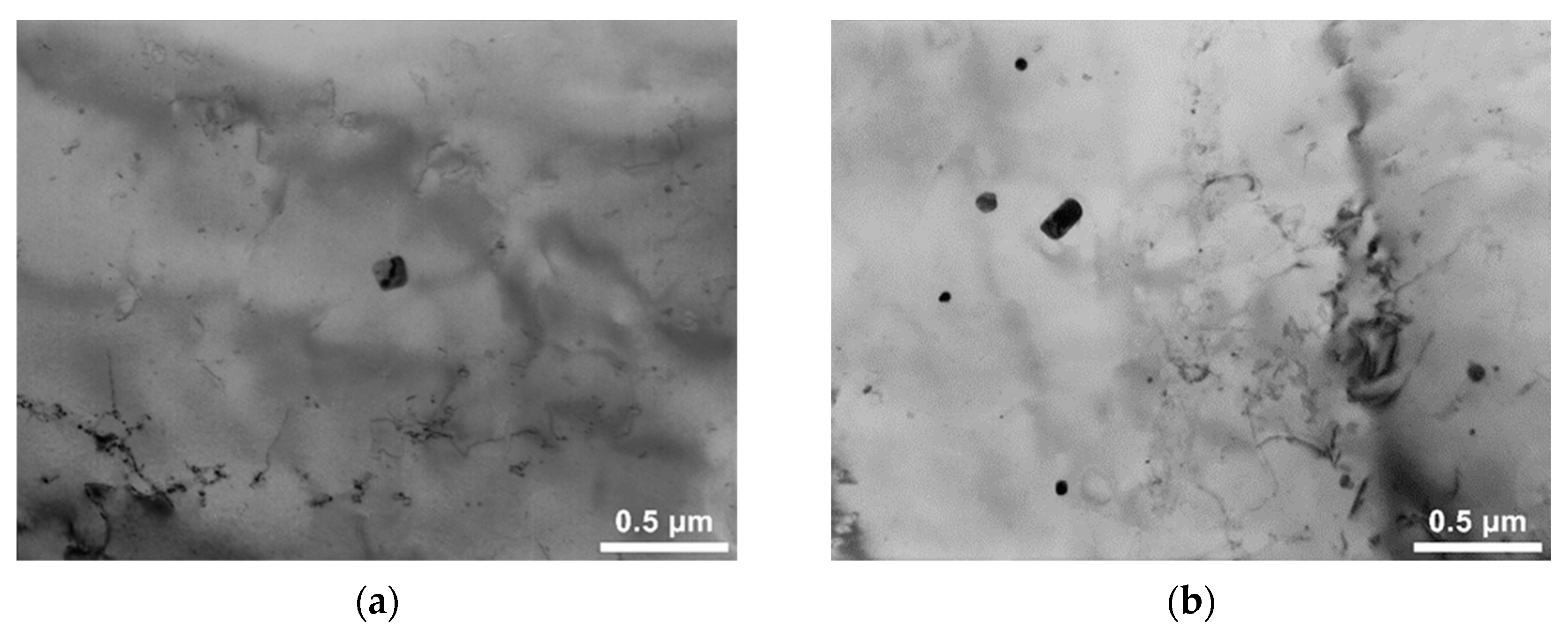
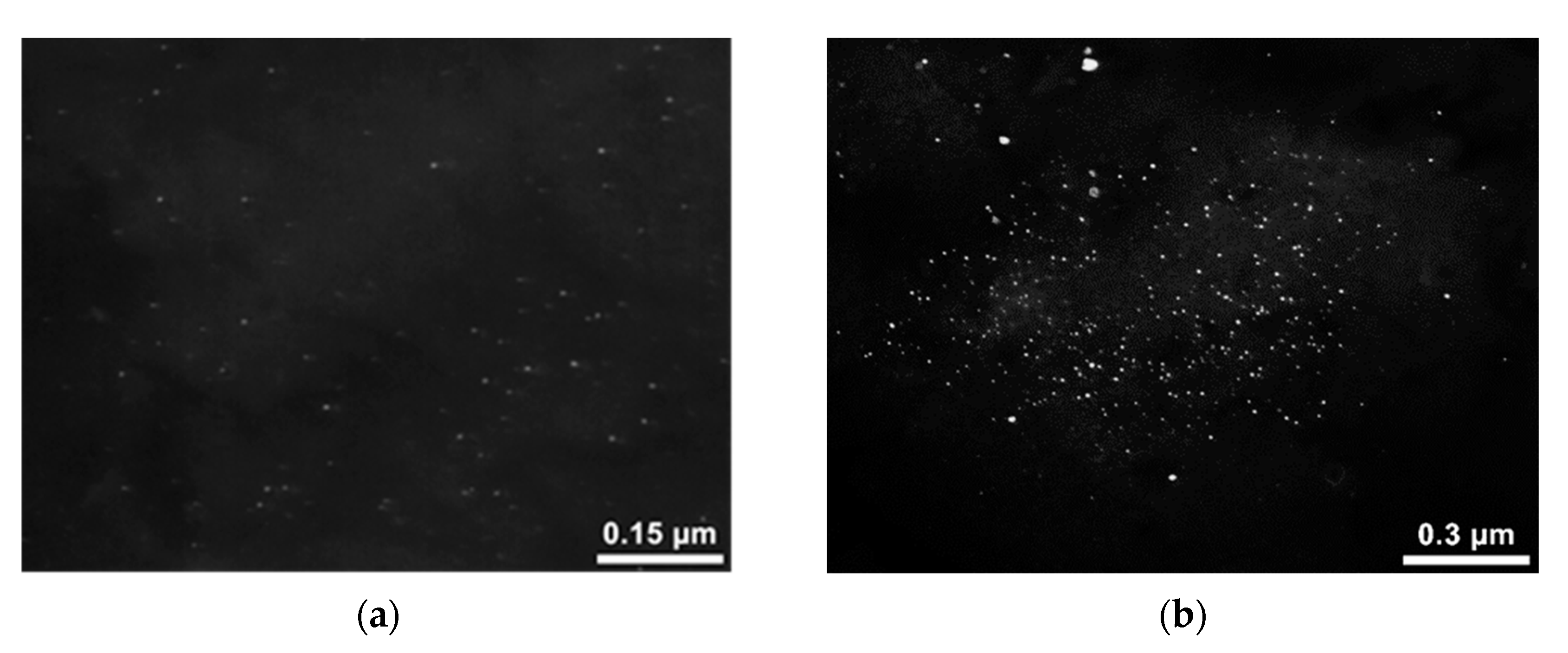

| Steel No. | C | Si | Mn | S | P | Cr | Ni | Cu | N | Al | Nb |
|---|---|---|---|---|---|---|---|---|---|---|---|
| 1 | 0.06 | 0.03 | 0.47 | 0.009 | 0.01 | 0.03 | 0.03 | 0.06 | 0.006 | 0.034 | 0.026 |
| 2 | 0.07 | 0.07 | 0.73 | 0.007 | 0.01 | 0.04 | 0.03 | 0.06 | 0.006 | 0.043 | 0.050 |
| Steel No. | Batch No. | T6, °C | Tf, °C | TC, °C | Annealing Temperature, °C | |||||||
|---|---|---|---|---|---|---|---|---|---|---|---|---|
| P3 | P4 | P5 | P6 | P7 | P10 | P11 | P12 | |||||
| 1 | 1-1 | 1010 | 840 | 575 | 734 | 756 | 767 | 681 | 431 | 412 | 356 | 309 |
| 2 | 2-1 | 1052 | 856 | 585 | 732 | 756 | 764 | 678 | 430 | 411 | 355 | 311 |
| 2 | 2-2 | 1052 | 854 | 580 | 748 | 778 | 783 | 680 | 430 | 420 | 362 | 312 |
| Steel No. | Batch No. | Mechanical Properties | Corrosion Rate | ||
|---|---|---|---|---|---|
| σT, MPa | σB, MPa | δ, % | Δm/S, g/m2 | ||
| 1 | 1-1 | 335 | 416 | 26.5 | 8.7 |
| 2 | 2-1 | 375 | 492 | 22.5 | 5.7 |
| 2 | 2-2 | 371 | 468 | 23 | 5.7 |
| Batch No. | Dy, μm | Dx, μm | Dx/Dy | Da, μm |
|---|---|---|---|---|
| 1-1 | 4.79 | 6.91 | 1.44 | 5.85 |
| 2-1 | 3.95 | 7.25 | 1.83 | 5.6 |
| 2-2 | 3.80 | 6.10 | 1.61 | 4.95 |
Publisher’s Note: MDPI stays neutral with regard to jurisdictional claims in published maps and institutional affiliations. |
© 2022 by the authors. Licensee MDPI, Basel, Switzerland. This article is an open access article distributed under the terms and conditions of the Creative Commons Attribution (CC BY) license (https://creativecommons.org/licenses/by/4.0/).
Share and Cite
Rodionova, I.; Arutyunyan, N.; Amezhnov, A.; D’yakonov, D.; Gladchenkova, Y.; Dunaev, S.; Vasechkina, I. Effect of Nanosized Precipitates on Corrosion Resistance of Nb-Microalloyed Steels. Metals 2022, 12, 636. https://doi.org/10.3390/met12040636
Rodionova I, Arutyunyan N, Amezhnov A, D’yakonov D, Gladchenkova Y, Dunaev S, Vasechkina I. Effect of Nanosized Precipitates on Corrosion Resistance of Nb-Microalloyed Steels. Metals. 2022; 12(4):636. https://doi.org/10.3390/met12040636
Chicago/Turabian StyleRodionova, Irina, Nataliya Arutyunyan, Andrey Amezhnov, Dmitrii D’yakonov, Yuliya Gladchenkova, Sergey Dunaev, and Irina Vasechkina. 2022. "Effect of Nanosized Precipitates on Corrosion Resistance of Nb-Microalloyed Steels" Metals 12, no. 4: 636. https://doi.org/10.3390/met12040636
APA StyleRodionova, I., Arutyunyan, N., Amezhnov, A., D’yakonov, D., Gladchenkova, Y., Dunaev, S., & Vasechkina, I. (2022). Effect of Nanosized Precipitates on Corrosion Resistance of Nb-Microalloyed Steels. Metals, 12(4), 636. https://doi.org/10.3390/met12040636






